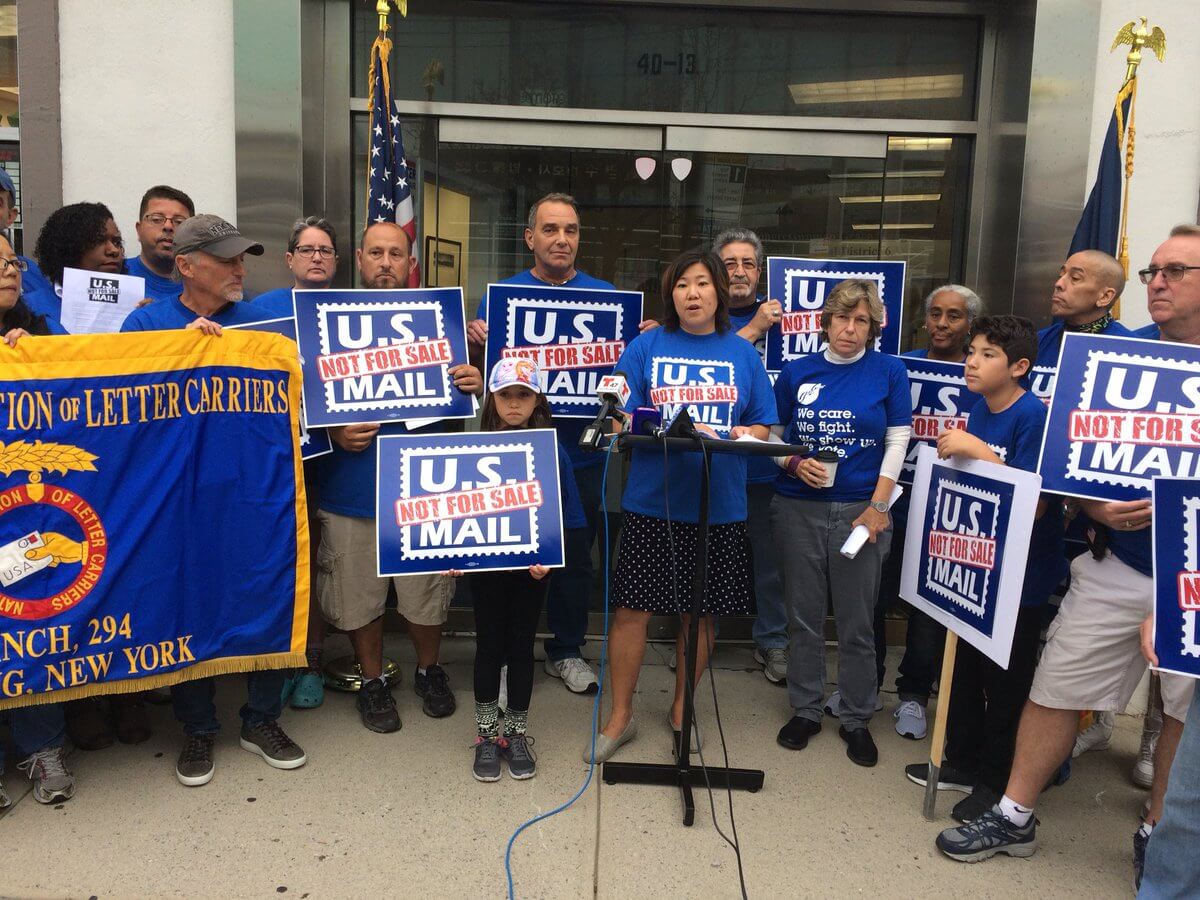Dozens of Queens postal workers banded together in Flushing to make clear that “U.S. mail is not for sale.”
Congresswoman Grace Meng joined Queens postal workers on Monday, Oct. 8, to oppose President Trump’s plan to privatize the United States Postal Service (USPS). Representatives from several postal unions attended the rally, including the National Association of Letter Carriers, American Postal Workers Union and National Postal Mail Handlers.
The press conference took place at 40-13 159th St. and was part of the countrywide movement called “U.S. Mail Not For Sale.” Rallies were held in New York, Washington, D.C., California, Florida and other states, and protesters gathered wearing shirts, holding banners and marching through the streets.
The participants in the Queens rally held banners baring the words “Don’t privatize our public post office” and “Remember in November, Vote.”
“The American people and small businesses rely heavily on the Postal Service and if the agency is privatized, we all stand to be socked with higher delivery costs and a reduction of service, particularity in areas where it’s not profitable for private companies to make deliveries,” said Meng. “Privatization may also put the jobs of our hard working postal employees on the chopping block. It’s clear what we must do. We must take this privatization plan, stamp return to sender on it, and make sure it goes straight back to 1600 Pennsylvania Avenue!”
Proud to stand with postal workers from across #Queens to protest @RealDonaldTrump’s proposal to privatize the U.S. Postal Service. The U.S. mail is #NotForSale! #USPS pic.twitter.com/w4OML1YW1A
— Grace Meng (@RepGraceMeng) October 8, 2018
“This is about our values as a country.” – @rweingarten pic.twitter.com/QYA4ZadHJr
— AFT (@AFTunion) October 8, 2018
Since its inception by the Post Office Department in 1971, the U.S. Postal Service has been a government-run agency that “relies on the sale of postage, products and services to fund its operations” rather than on taxpayers’ money. A report from the USPS showed that the agency’s revenue was $69.6 billion for the 2017 fiscal year — a $1.8 billion decline in revenue from 2016. The report said that mail volume declined by 5 billion pieces, or 3.6 percent last year.
According to the agency, the actual source of the USPS’ debt is not a decline in mail volume but a 2006 law that requires them to “pre-fund” retiree health benefits instead of a “pay-as-you-go” method that other federal agencies employ.
“The pre-funding requirement, as it currently stands, contributes significantly to postal losses. Under current law, the Postal Service must follow a mandated pre-funding schedule of $5.5 billion to $5.8 billion per year through 2016. In 2009, Congress granted a much needed deferral, allowing us to pay $4.0 billion less than the originally required $5.4 billion payment. This year, Congress opted not to provide this deferral,” said the USPS in 2010.
Back in June of this year, the president introduced Delivering Government Solutions in the 21st Century, in which he outlined plans to restructure the USPS from a government entity to a private corporation. The plan stated that privatizing the postal service would have a “substantially lower cost structure” that would not burden taxpayers.
An excerpt from the proposal noted: “Like many European nations, the United States could privatize its postal operator while maintaining strong regulatory oversight to ensure fair competition and reasonable prices for customers.”
Trump issued an executive order called the Task Force on the United States Postal System, which was responsible for evaluating the operations and finances of the USPS and making recommendations. Although task force recommendations were set to be reported in August, written reports said that the president planned to keep the results secret until after the mid-term elections in November.




































